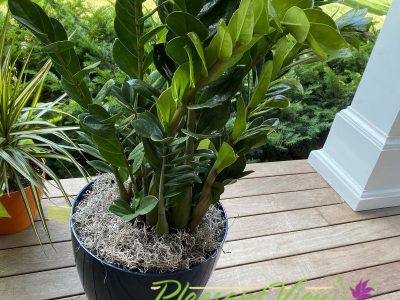by Barrie Anderson
My eyes were following the soapy rag up and down the leaves of the Sansevieria my mother was washing. I couldn’t believe she gave her houseplants a “bath”. Being 6 or 7 at the time, I remember being enthralled at how shiny the leaves became and how clean each plant appeared after mom took care of them.
Preparing our houseplants for the duration of the cold season is a necessity here in the upper Midwest. The 4 main components to the successful transfer and maintaining of your houseplants are acclimating to lower light conditions, cleaning your plants, setting up your indoor garden and maintaining the houseplants through the cold season.
I notice about the beginning of September mom moves to the porch, her Schefflera digitatas (Umbrella Plants), Sansevierias (Mother in law Tongues), Auracaria heterophyllas (Norfolk Island Pines), Streptocarpus sect. (African Violets) and many more, to acclimate them to lower light conditions that winter offers. This is important training for the plants because once they receive less light, they won’t be growing as much, won’t require as much watering and in turn won’t need hardly any fertilizer. It’s common for any plants you bring inside to experience some leaf drop. This is due to the lower light conditions, but don’t panic, this is simply the plant making adjustments.
Cleaning your plants before bringing them inside is crucial to their survival. You do not want to bring inside any pests that may jump from one plant to the next! Pretty soon your entire indoor garden will be infested so please take time to inspect for bugs, and treat them accordingly. This is why my mom moves her plants to a shadier spot, inspect for pests, and then begins to clean them. She uses plain old Zest soap in lukewarm water and gently washes the leaves of all her plants except the African Violets, they do not like water on their leaves! It is a process, but well worth it as her plants rarely if ever become riddled with pests. If you don’t feel like washing your plants with soapy water, go ahead and purchase an insecticidal soap from your local nursery or whatever spray you’re comfortable applying.
Selecting the area for your plants to ride out the winter is just as important as the steps above. If they can’t attain sufficient light, and have decent airflow, they will become stressed and their chance for survival is diminished. Mom places her plants in her sewing room and on the landing of the stairs to the second level. She does this because those areas have south facing windows and will receive the most daylight during winter. The plants love it! They get enough light that during the winter she turns her pots so all sides get equal light throughout the winter! You’ll notice your plants “leaning” or the majority of their leaves facing the window. This is the plant yearning for some sun, so oblige them by giving them a turn to face that window and soak up some light.
Maintaining your indoor garden throughout winter is where your skills as a gardener will be tested. Too many people overwater their plants once they’re inside. We are used to watering regularly throughout the summer, and rightly so, but we must remember that when these plants are now inside, they are not receiving the 10-12 hours of light and warm temps they enjoyed during the season. As a result, they are just above dormancy while inside so we must treat them that way, and the first order of business is to NOT OVERWATER! My mom waters her African Violets 1 TBSP about every 10 days inside, if that. Now, for the other green – leaved, larger plants the water requirements are different, but still cut way back on watering. Once a week watering will suffice for most houseplants during winter. The trick is to check the soil prior to watering. Stick your finger in the soil down about 1-2 inches and if it’s still moist, your plant is just fine and doesn’t require water. Also, fertilize them ONCE when you bring them inside and not again until you take them outside again in spring. Remember, your plants are growing very slowly indoors, receiving much less light and experiencing far less humidity now, so cut back on the food and water. Don’t forget to give your plants a nice lukewarm shower once in a while during winter. Take your Shefflera or Diffenbachia, carry them to the bathroom and turn on the shower to tickle their leaves a bit! They’ll appreciate the simulated, gentle, spring rain in the middle of January.
There you have it! Preparing your houseplants for a Minnesota winter is a snap, and once you do it, you become an expert rather quickly.

